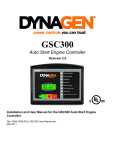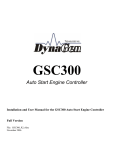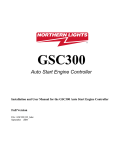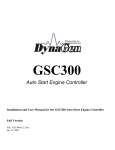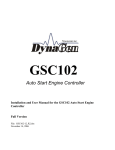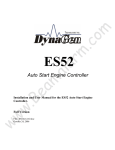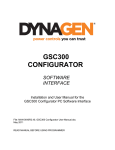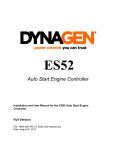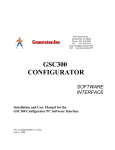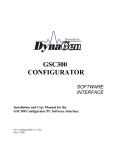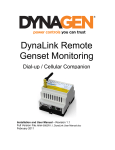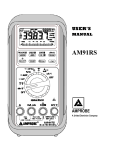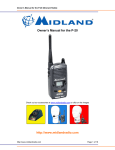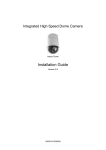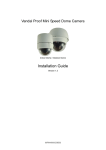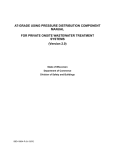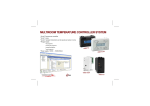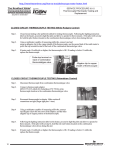Download GSC300 User Manual R2.12
Transcript
GSC300 Auto Start Engine Controller Revision 2.12 Installation and User Manual for the GSC300 Auto Start Engine Controller File: MAN-0039 R2.12, GSC300 User Manual.doc June 2014 2 of 28 Thank You For Purchasing This DynaGen Product Please Read Manual Before Installing Unit Receipt of Shipment and Warranty Return Information Upon receipt of shipment, carefully remove the unit from the shipping container and thoroughly examine the unit for shipping damage. In case of damage, immediately contact the carrier and request that an inspection report be filed prior to contacting DynaGen. All returned items are to be shipped prepaid and include a Return Material Authorization (RMA) number issued by DynaGen. Limited Warranty For warranty information refer to the standard terms and conditions of sale at http://www.dynagen.ca. Dynagen GSC300 Webpage For up-to-date manuals and other information please see the GSC300 section of the DynaGen website at: www.dynagen.ca/products/GSC300.htm or www.dynagen.ca/support U 3 of 28 GSC300 Specifications Operating Voltage Current Consumption Operating Temperature Physical Dimensions 7 to 30VDC continuous. Zero volts operation for 100mS (assumes supply was 12VDC before initiating starting). Standby current: 40mA. Actual Unit Weight 0.458 lbs Enclosure High Impact Resistant, Injection Molded Plastic Enclosure Front Panel Indications LCD Display High intensity LED’s with regulated brightness -Ultra-bright, Backlight LCD display with optimum viewing angle of 0 to -25º from perpendicular -Display Size (mm): 8 (W) x 32 (H) x 12.8 (D) x (2line x 8 character display) Adjustments Warm-up Cool-Down Crank Disconnect Overspeed Crank Rest Delay on Start Crank Tries Oil Bypass Low Battery Indication Glow Plug/Preheat Timer Adjustments -40 ºC to +70 ºC (LCD Display operates from to -16 ºC to 70 ºC) 4.5"(H) x 5.5"(W) x 1.25"(D) 0 - 200 Seconds (After Oil Bypass Feature) 0 - 812 Seconds 12 to 140Hz 40 – 200Hz 4 - 32 Seconds 0 – 59 Seconds 1 to 10 10 – 55 Seconds 7 – 35VDC 0 - 255 Seconds Energize To Stop (ETS) Inputs Protection Energizes for 15 Seconds on failures, or energizes until 5 Seconds after engine speed goes to zero upon removing power from Start/Stop terminal or removing the unit from manual mode using the front panel buttons. -Generator Output Speed Sensing Speed Sensing -Maximum Input Voltage: 300VAC RMS -Minimum Input Voltage: 1.5VAC ptp at 20Hz 10VAC ptp at 60Hz -60Hz Rejection Filter Included -Loss of Speed Signal Included Sender/Failure Oil Pressure Inputs Coolant Temperature Fuel Level / Auxiliary Input -Accepts standard industry low impedance (0-500 ohm) sender inputs (VDO, Stewart-Warner, Datcon, Murphy, etc.) -Programmable for either switch or sender configuration using PC Interface -Adjustable failure set-points using PC Interface -Three on-board replaceable 30A fuses protect Fuel, Crank, and Timer Outputs -Reverse polarity protected -Short circuit & overload protection on annunciation outputs -Inputs are electrostatic discharge protected J1113-11 Transients – Pulse 1A (Supply Disconnect), Pulse 2A (Sudden Disconnect), Pulse 4 (Starter Motor Engagement), Pulse 5 (Load Dump). Details of the test parameters are available, please consult with factory. 4 of 28 -All outputs switched to +battery (sourcing) -Fuel, Crank, and Timer Outputs: 12V/30A or 24V/20A each, using standard automotive relays -Annunciation Outputs: 1 on = 300 mA, 2 on = 230 mA, 3 on = 160 mA, 4 on = 123 mA, 5 on = 91 mA, 6 on = 80 mA, 7 on = 66 mA, 8 on = 52mA Connections -Removable terminal block for annunciation outputs and low power connections -0.25" spade terminals for high current and Main power inputs Programming -Windows based software interface utilizing the USB port of your PC -Needs no power to program using the PC Interface – uses power from USB port of PC -Specifications May Change Without Notice Outputs 5 of 28 Table of Contents 1. 2. GSC300 Product Number Identification ......................................................................................... 6 Wiring Installation Guidelines ........................................................................................................ 7 2.1 Mounting .................................................................................................................................. 7 2.2 General .................................................................................................................................... 7 2.3 GSC300 12/24VDC System Operation .................................................................................... 8 2.4 Terminal Description ................................................................................................................ 9 2.5 System Wiring Diagram ......................................................................................................... 12 2.6 Back Panel Layout ................................................................................................................. 14 3. Controller Operation .................................................................................................................... 15 3.1 OFF/ AUTO/ RUN Modes ...................................................................................................... 15 3.2 General Failure Conditions .................................................................................................... 15 3.3 Hour Meter ............................................................................................................................. 16 3.4 Outputs .................................................................................................................................. 16 3.5 LED Layout ............................................................................................................................ 17 3.6 LED Indications...................................................................................................................... 18 4. Programming the GSC300 Settings............................................................................................. 19 5. Troubleshooting Guidelines ......................................................................................................... 21 6. Technical Notes and FAQ ............................................................................................................ 22 6.1 Controller Memory Clear Time ............................................................................................... 22 6.2 Step Down Transformer Use On Speed Sensing Cable With Inverter Systems .................... 22 6.3 Pull and Hold Coil .................................................................................................................. 23 6.4 Emergency Stop Switch ......................................................................................................... 23 6.5 Automatic Start on Low Battery ............................................................................................. 23 6.6 GCP300 Panel (Optional) ...................................................................................................... 24 6.7 GSC300 Cutout Template ..................................................................................................... 26 6 of 28 1. GSC300 Product Number Identification The GSC300 series catalog order number provides information pertaining to a specific model. The Product Number Identification Table (see Table 1) provides details on the breakdown of the model number. Table 1 – Identification Table Position 1-6 Position 8 Position 10-11 Position 13-14 Series Speed Range DC Voltage Labeling GSC300 = GSC300 L=Low H=High (consult factory) 12=12VDC 24=24VDC LS=Standard LX=Customized Example: The product number GSC300-L-12-LS would be described as follows: A GSC300 series automatic engine controller configured for a 12 VDC system. The controller is factory configured for low speed range (generator speed range) which includes standard labeling. A GSC300 serial number would be displayed as: GSC300-L-12-LS-00000 7 of 28 2. Wiring Installation Guidelines Danger: Never work on the engine while its power is on. This controller does not generate a warning signal prior to automatic engine start. Warning signs should be placed on engine equipment indicating this important safety measure. 2.1 Mounting See section 6.7 on page 26 for the GSC300 mounting dimensions. The maximum torque is 7in-lbs for the three GSC300 mounting screws. The screws are zinc platted 8-32 X 5/16" machine screws. 2.2 General Following these instructions will help avoid common installation problems during wiring and setup. Table 2 – Wiring Sizes Terminal 1 2 3 4 5 6 7 8 9 10 11 - 18 11 12 13 14 15 16 17 18 19 20 21 22 Wire Size1 (AWG) 12 12 12 12 12 12 12 12 18 18 18 18 18 18 18 18 18 18 18 18 18 18 18 Current maximum Function 12V/30A, 24V/20A 12V/30A, 24V/20A 12V/30A, 24V/20A 12V/30A, 24V/20A 12V/30A, 24V/20A 12V/30A, 24V/20A 12V/30A, 24V/20A 12V/30A, 24V/20A 100mA 100mA 350mA* 300mA 300mA 300mA 300mA 300mA 300mA 300mA 300mA 7mA 7mA 7mA 7mA Fuel Output Terminal Auto(Battery +) Terminal Connection Auto(Battery +) Terminal Connection Crank Output Terminal Ground Terminal Connection Ground Terminal Connection Preheat/ETS Terminal Preheat/ETS Terminal Speed Signal Connection Speed Signal Connection Annunciator Outputs Overcrank (failure to start) Output Overspeed Output High Temp Output Low Oil Output Low Battery Output Engine Run Output Not in Auto Output General Failure Output Start/Stop Input Oil Pressure Sender/Switch Input Temperature Sender/Switch Input Fuel Level/Auxiliary Sender/Switch Input *This is the maximum current for each terminal. Use for specifying wire size only. 1 Recommended wire size. 8 of 28 1. Battery must be disconnected before any wiring connections are made. 2. Wire length from the engine to the controller should not exceed 6 meters (20 feet). 3. Wiring size and type should be as specified below. Use stranded wire, since solid wire has a tendency to crack, break and loosen over time. 4. WARNING: Relays are rated for maximum 30A at 12V. If relays are being used at 24V maximum rating is 20A. Relays are rated for resistive ratings. When driving such loads as starter solenoids you must ensure proper de-rating of the relays. Consult factory for further details. 5. DO NOT use wire smaller than 18 AWG as smaller wire has a tendency to crack and break over time. 6. IMPORTANT: The connections supplying DC power to the GSC300 panel should preferably run directly from the battery posts with no splices or other connections. Avoid using chassis (aluminum or iron engine parts), as return conductor for battery negative voltage. Copper wiring is recommended. Failure to follow the above may result in erratic operation due to large voltage drops across wiring connections. A small fuse should be placed at the battery terminal to provide 12 volts to the Remote Start Contacts to ensure that a short along this line will not cause any damage. 7. Follow all instructions / guidelines given in Table 3 below for the individual terminals. 2.3 GSC300 12/24VDC System Operation ! PRE-HEAT RELAY 9 10 7 6 3 2 40 A 1 FUEL RELAY 12VDC RELAYS PRE-HEAT RELAY 9 10 7 6 5 4 CRANK RELAY 40 A 40 A 4 CRANK RELAY 8 40 A 5 22 21 20 19 18 17 16 15 14 13 12 11 40 A 40 A 8 ! FUEL RELAY 3 2 1 12VDC RELAYS MUST BE INSTALLED FOR 12VDC SYSTEM OPERATION 24VDC RELAYS 22 21 20 19 18 17 16 15 14 13 12 11 24VDC RELAYS MUST BE INSTALLED FOR 24VDC SYSTEM OPERATION Figure 1 The GSC300 controller is designed to operate in either 12 or 24VDC system voltages. When operating in 12VDC systems the Fuel, Crank and Preheat/ETS relays need to be the 9 of 28 12VDC relay type. When operating in 24VDC systems these relays need to be the 24VDC relay type. Contact the factory if relays are required. Approved relays for 12 or 24VDC system operation are as follows: AZETTLER – AZ973-1C-12DC for 12VDC operation AZETTLER – AZ973-1C-24DC for 24VDC operation 2.4 Terminal Description Table 3 – GSC300 Terminals Term # 1 2,3 4 5,6 7,8 Description Fuel Output provides 12V/30A or 24V/20A maximum. Fuel Output closes to +12/24VDC when start signal is received, and opens when either an engine failure occurs or when Cool Down period has ended. Battery Positive Terminals. Main +Battery power connection to controller. These terminals are internally connected together on GSC300 controller. Crank Output provides 12V/30A or 24V/20A maximum. Crank Output closes to +12/24VDC during cranking, and opens when the engine has started, or during Crank Rest. Main Battery Ground connection for the controller module. A good ground connection, directly from the battery, is required for proper operation. These terminals are internally connected together on GSC300 controller. Preheat/ETS Output provides 12V/30A or 24V/20A maximum. It provides a set of dry contacts between terminals #7 and #8. When this output is energized terminals #7 and #8 are connected together. When output is OFF terminals #7 and #8 have no connection. To verify the operation of the Preheat/ETS Output, measure the resistance between the Preheat/ETS terminals when the Preheat/ETS Output is ON, it should read a closed circuit (i.e. zero ohms). When the output is OFF there should be an open circuit between the terminals (very high resistance). 10 of 28 9 , 10 Speed. Options: Generator Output (L-Version) or Mag Pickup (H Version) Generator Output (L-Version) Speed Signal Input for Crank Disconnect, Engine Run, and Overspeed sensing. 300VAC max input voltage. Speed sensing input terminals (#9, #10) do not have polarity sensitivity therefore the AC generator output leads can be connected in any polarity configuration. Do not exceed 300VAC on speed sensing input terminals. Refer to the specifications for the minimal input voltages. Mag Pickup (H-Version) The magnetic pickup only works for frequencies up to 3000Hz (this is max of 100 teeth at 60Hz) If using magnetic pickup as the speed sensing source the maximum frequency allowed into the controller is 3000Hz. Frequencies higher than this will cause the hourmeter and other timings to become inaccurate. For example at 3500Hz the hourmeter error will be 5%. Frequency = (Number of teeth * engine speed in RPM) / Generator Output Hz E.g. Number of teeth = 100, engine speed = 1800RPM, Generator Output Hz at 60Hz the frequency would be: (100 * 1800) / 60 = 3000 Hz The following values are minimal recommended RMS voltages: 1000Hz – 0.6V (600mV) 3000Hz – 0.85V (850mV) 11 - 18 General The GSC300 does not have loss of speed detection during cranking. If there is no speed signal but the genset starts up and runs the starter will remain engaged for the remainder of the crank cycle. Outputs The maximum rating of each output depends on how many outputs are on simultaneously. Do not exceed these values: 1 on = 300 mA, 2 on = 230 mA, 3 on = 160 mA, 4 on = 123 mA, 5 on = 91 mA, 6 on = 80 mA, 7 on = 66 mA, 8 on = 52mA. Good practice is to use 50% of the maximum rating. Do not connect power to the outputs. If there is power on these outputs when the GSC300 is unpowered the GSC300 will be damaged. Install a diode between the output and power source to prevent back feed. 11 12 13 The outputs have over-current protection which turns off the output in an over-current condition. To reset the over-current protection power down the controller for 30s and power back up. Overcrank Output closes to +12/24VDC on Overcrank Failure. Overspeed Output closes to +12/24VDC on Overspeed Failure. High Temp Output closes to +12/24VDC upon High Temp Failure. 11 of 28 14 15 16 17 18 19 20 - 22 Low Oil Output closes to +12/24VDC upon Low Oil Failure. Low Battery Output closes to +12/24VDC on Low Battery Condition. When a low battery condition is detected this output turns on immediately. When the low battery condition is removed this output remains on for 5s before turning off. Engine Run Output closes to +12/24VDC on Engine Run Condition. Not In Auto Output closes to +12/24VDC when unit is not in auto. General Failure Output closes to +12/24VDC on a General Failure. Start Stop Input (i.e. Remote Start Contacts). Apply +12/24VDC to this terminal while unit is in Auto Mode to start engine. Remove +12/24VDC to stop engine or enter CoolDown mode. Maximum distance for the remote start contacts There is no absolute maximum since this depends on the size and type of the wire used. There needs to be a minimum voltage of 8VDC at the Start/Stop input for a start to be detected. The wiring should be rated assuming a maximum 0.1A current draw. There could be large voltage drops over long distances. Mounting an external relay close to the controller and controlling it with the remote switch is a good solution. Sensor Inputs Engine Sensor type MUST be selected and programmed properly to GSC300 (switch or sender type). Failure to do so may result in the controller not shutting down on true engine failure (Low oil pressure or high engine temperature). When installing engine sensors (oil pressure, engine temperature, fuel level) ensure the switches are connected to ground circuit through the engine sensor. Damage will occur to controller unit if the sensor input terminals (Terminal #’s 20, 21 and 22) are connected to +Battery. 20 When using engine sensors that are the resistive type the proper manufacturer of the sender MUST be selected during programming. Failure to select the correct manufacturer type will cause inaccurate readings as well as failure to protect the engine during a fault condition. Low Oil Pressure sensor input. This sensor can be the resistive type (Sender) or can be the switch type. The proper type of sensor must be selected during GSC300 controller programming. The sender or switch must be connected to ground for proper operation. If +Battery is connected to input terminal this can result in damaged to GSC300 controller. When using a sender, the proper sender manufacturer must be selected as each sender manufacturer’s characteristics are different; the sender failure set-point must also be selected. When using a switch NO or NC much be selected from the programming menu. NO refers to the state of the contacts during normal engine operation, therefore NO refers to normally open at normal engine run and close to ground on low oil pressure failure. 12 of 28 21 22 High Engine Temperature sensor input. This sensor can be the resistive type (Sender) or can be the switch type. The proper type of sensor must be selected during GSC300 controller programming. The sender or switch must be connected to ground for proper operation. If +Battery is connected to input terminal this can result in damaged to GSC300 controller. When using a sender, the proper sender manufacturer must be selected as each sender manufacturer’s characteristics are different; the sender failure set-point must also be selected. When using a switch the switch must be the NO type on normal engine run and close to ground on failure. Fuel Level sensor or Auxiliary failure input. This sensor can be the resistive type (Sender) or can be the switch type. The proper type of sensor must be selected during GSC300 controller programming. The sender or switch must be connected to ground for proper operation. If +Battery is connected to input terminal this can result in damaged to GSC300 controller. When using a sender, the proper sender manufacturer must be selected as each sender manufacturer’s characteristics are different. When using a switch the switch must be the NO type on normal engine run and close to ground on failure. 2.5 System Wiring Diagram See below. Figure 2 – GSC300 System Wiring Diagram 14 of 28 2.6 Back Panel Layout PRE-HEAT COM 7 BATTERY GROUND 6 BATTERY GROUND 5 STARTER OUTPUT 4 BATTERY + 3 BATTERY + 2 1 40 A FUEL OUTPUT PRE-HEAT RELAY 9 22 21 20 19 18 17 16 15 14 13 12 11 10 SPEED SIGNAL INPUTS 40 A 8 40 A PRE-HEAT NO CRANK RELAY FUEL RELAY PROGRAMMING CONNECTOR ON MODE SWITCH Figure 3 (Note: fuses are 30A, not 40A) OFF AUX SWITCH INPUT TEMP. SWITCH INPUT OIL SWITCH INPUT REMOTE START INPUT GENERAL FAIL OUTPUT NOT IN AUTO OUTPUT ENGINE RUN OUTPUT LOW BATTERY OUTPUT LOW OIL OUTPUT HIGH TEMP. OUTPUT OVER-SPEED OUTPUT OVER-CRANK OUTPUT 15 of 28 3. Controller Operation 3.1 OFF/ AUTO/ RUN Modes On power up the controller defaults to the mode it was in when power was last removed (AUTO or OFF). OFF mode can be entered by pressing the OFF button on the front panel. When the GSC300 is in the OFF mode the “Not In Auto” LED will be lit on the front panel (NOT IN AUTO below). When the GSC300 is in the OFF mode, starting – either from the remote start contacts or from the front panel run button – is disabled. To start the genset the GSC300 needs to be placed in the AUTO mode by pressing the AUTO button on the front panel. Once in AUTO mode the genset can be started by pressing the RUN button. Once crank success is achieved (i.e. engine has started), the GSC300 enters the RUN mode and the front panel ENGINE RUNNING LED will be lit. Removing power while the controller is in the RUN mode may corrupt the EEPROM. If this occurs, the GSC300 will have to be reprogrammed. 3.2 General Failure Conditions The following conditions can cause the GSC300 controller to shutdown the engine-generator system unexpectedly. To reset a failure press the Off key for 3 seconds. This will exit the FAILURE mode and take the controller back to the OFF mode. Auxiliary Failure (“XTR_FAIL”) Low Oil Pressure High Coolant Temperature Overcrank Overspeed Loss of Speed (“SPDLOSS”) Extra failure is indicated by a flashing RED Low oil pressure LED Low Oil pressure is indicated by a steady on RED Low oil pressure LED High coolant temperature is indicated by a steady on RED High water temp LED Overcrank failure is indicated by a steady on RED Overcrank LED Overspeed failure is indicated by a steady on RED Overspeed LED Loss of speed signal is indicated by a flashing RED Overspeed LED The General Failure output annunciation is triggered during any of the above failure conditions and is rated 300mA Max. NOT IN AUTO: When the controller is in the OFF Mode, the NOT IN AUTO LED will illuminate and the NOT IN AUTO Output will be triggered. During this OFF mode Automatic engine starting is disabled. The LCD display will read “OFF”, and the backlight on the LCD display will be off. NOTE: + Battery must be permanently connected to the main power terminal for the NOT IN AUTO feature. LOW BATTERY VOLTAGE ALARM: When the battery voltage drops below the user defined set point which can be programmed between 7 and 35VDC, the engine controller displays a Low Battery Condition. The Low battery warning Led will be illuminated at any time during OFF, AUTO 16 of 28 and Manual run modes. The LCD display will indicate the message: “LOW_BATT”. The LOW battery warning will be disabled during failure conditions. LOW OIL INPUT: The Low Oil Input can be wired to a resistive sender or from a NO or NC type switch. NO / NC refers to the state of the contacts during normal engine operation (engine oil pressure ok). When utilizing a resistive sender the display units are fixed in PSI by the PC programming interface, and a failure set-point must be selected from the programming menu. Note: The oil input failure is disabled during the Oil Bypass time. HIGH TEMPERATURE INPUT: The high temperature input can be wired to a resistive sender or from a NO type switch. For proper operation while using a switch, the switch must be the NO type which closes to ground upon failure. When utilizing a resistive sender the display units are fixed in Fahrenheit by the PC programming interface, and a failure set-point must be selected from the programming menu. Note: The engine temperature failure is disabled during the Oil Bypass time. FUEL LEVEL/AUXILIARY INPUT: The Fuel level/Aux input can be wired to a resistive sender or from a NO type switch. For proper operation while using a switch, the switch must be the NO type which closes to ground upon failure. If this input is used as a sender, no failure will be indicated. The sender option is solely for Fuel Level/Auxiliary Level Display on the LCD. 3.3 Hour Meter The controller displays a log of total accumulated generator running hours. Generator Run times will be displayed on the controllers display screen. The display represents both hours and minutes in the form 123456:7. The last digit on the hour meter will represent the time in 1/10 of an hour. Please note that although the hour meter displays time in hours and minutes, it will record up to the nearest second. If the generator was operated for a 3 minute period and then stopped the running time is stored in permanent memory and then adding to the next running period. The same would be true if the controller were to enter a failure mode as the controller would permanently store the remaining time for the next running cycle. The maximum hour count is 99,999.9 hours, after which it will continue to display 99,999.9 indefinitely. 3.4 Outputs If a switched output is overloaded it will go into a fault state and turn off. You must remove power to the GSC300 for 30s to reset the outputs. 17 of 28 3.5 LED Layout Front View of GSC300 Figure 4 18 of 28 3.6 LED Indications The GSC300 does not have a LED lamp test feature. Table 4 – Front Panel LED Indications LED Appearance Not in Auto LED is ON. No LED’s ON Steady Low Oil LED Flashing Low Oil LED Steady High Temperature LED Steady Overcrank LED Steady Overspeed LED Flashing Overspeed LED Steady Engine Running LED Flashing Engine Running LED Condition/Failure Unit is in OFF state, and automatic starting is disabled “OFF”, no +12/24VDC to main power terminal. Low Oil Pressure Failure Auxiliary Input Failure Over Temperature Failure Engine-generator failed to start after the specified number of cranking attempts. Speed Signal present above Overspeed setting The speed signal was Zero while running. The engine has stalled (overload or lack of fuel), or the speed signal has been lost. Engine Controller is in running mode of operation. Crank Rest period. Cranking will resume soon. 19 of 28 4. Programming the GSC300 Settings The GSC300 cannot be powered while using the parallel port or USB programmer. The GSC300 could be damaged. Programming the GSC300 requires a special USB programmer supplied by Dynagen. The part number is GSC300-USB-PGMR. Detailed instructions on the PC interface are included with the GSC300 Configurator software. A sample interface screen is illustrated on the following page. General Programming Notes 1. The GSC300 must be unpowered when programming. Ensure it is not connected to battery or other power source. Parallel Port Programming Note 1. The parallel port programmer has been discontinued. 2. Black wire should face towards center of GSC300. USB Programming Note 1. Blue wire should face towards centre of GSC300. 2. If the presto ON-LINE LED it not lit and the presto USB cable is plugged in, the USB drivers did not properly install. Go to the device manager and locate “ASIX PRESTO Programmer” under “Universal Serial Bus Controllers”. Right click on it and select Update Driver or similar. The drivers are located in the directory you installed the PC Interface to. For Vista and 7 they should have been placed on your desktop during installation. Both the parallel port and USB programmers directly power and program the EEPROM on the GSC300. The GSC300 on board microcontroller is not involved so it is not simple serial communications like the GSC400. 20 of 28 Sample Screen from PC Interface NOTE: Factory default settings are outlined in the photo below Figure 5 21 of 28 5. Troubleshooting Guidelines TROUBLE Unit does not operate when powered to test mode Engine starts and immediately goes into Overspeed shutdown Engine does not crank Engine cranks but does not start Engine starts but shuts down after “Oil BypassTM period” due to low oil/high temp/Aux input POSSIBLE CAUSE Power leads to unit are reversed Bad ground connection from engine to controller unit. Improper Overspeed setting Battery is low or terminals are dirty Crank circuitry wiring improperly connected Bad ground connection from engine to controller Crank relay damaged. Or on board fuse is blown Out of fuel Ignition control wiring not installed properly Fuel relay and or fuse damaged Oil/Temp/Auxiliary input wiring improperly connected. SUGGESTED ACTION Confirm correct wiring for ground and +bat, and re-attempt testing. Run wire directly from battery - to the ground terminal #11on controller unit. Verify the Overspeed setting with PC configuration software. Confirm that engine’s governor is properly calibrated for its intended use. Clean terminals and re-charge battery Refer to engine control wiring section and check crank connections Run wire directly from battery - to the ground terminal #5 & 6, on controller unit. Check wiring, in line fuse and slave relay. Replace fuse, relay and re-test controller. Check fuel level, add fuel if necessary Refer to engine control wiring section and check ignition connections Check fuel relay and fuse, replace if damaged or blown. Check wiring for proper connections. Incorrect programming of sensor inputs. Check programming of oil pressure, engine temperature and aux input. Ensure that the sensor type is properly programmed to controller unit (Sender / Switch type) Flashing Overspeed LED Speed signal improperly connected, missing, or damaged. Crank output damaged, not working, or fuse blown on starter output Starter or starter solenoid damaged Check speed signal wiring; replace damaged speed signal source. Check wiring and replace relay of fuse where necessary. Replace/repair damaged starter or starter solenoid. Steady Oil LED immediately on start-up, without engine actually cranking or starting. False speed signal being detected by controller. This problem can sometimes occur in installations where there is AC power from inverters near generator output lines connected to the speed signal cable. Install a small step down transformer between the speed sensing wires and the generator output. Display Parameter for Temperature, Oil or Fuel displayed as >>> or <<< Parameter is >>> ABOVE or <<< BELOW specified manufacturer sender range. If further accuracy is required it may be necessary to install sender with proper range specifications. Warm-Up Feature appears longer then time setting. Warm-Up Feature time setting does not begin until the Oil Bypass Time has expired. Re-adjust Oil Bypass and/or Warm-Up timing. If the neutral from the generator output is not grounded, attach it to ground 22 of 28 6. Technical Notes and FAQ 6.1 Controller Memory Clear Time The GSC300 needs 10 seconds for its memory to clear. When the power to the controller is turned off and then back on again without waiting 10 seconds to clear the memory, a loss of speed will may be indicated by the GSC300 (if controller is in AUTO mode and start signal is activated) because the controller remains in run mode and senses that the generator has stopped. This would be indicated by a Flashing Overspeed LED. By leaving the GSC300 main power OFF for 10 seconds before main power is re-applied this allows the clearing the memory and it will function as intended. 6.2 Step Down Transformer Use On Speed Sensing Cable With Inverter Systems In some applications engine controllers are used on generators where there is no utility connection and inverters are used to provide AC power instead of a utility. Inverters can produce harmonics that can cause small AC signals to appear on wires that are near any power lines being fed by the inverter. If the generator output wires are located close to a line being powered by an inverter, a small AC signal can appear on the generator output lines when the inverter is on. This signal can cause the engine controller to react as if the generator is running if the speed sensing wires are connected to the generator output lines. This small AC signal can cause the controller to appear to have a Low Oil Failure when the remote start contacts are closed or the controller is put in the manual/test mode. The controller may think the generator is already running and immediately check to make sure there is oil pressure. Since the engine really hasn’t started yet, there is no oil pressure and the controller sees a low oil fault. This is seen as the Oil LED turning on steady even before the engine starts to engage the starter. Without this false speed signal the controller will not look for oil pressure until the engine has started to run and the crank disengages if oil verification is disabled. Simply installing a small transformer between the generator output and the speed sensing terminals on the controller can eliminate this false speed signal. This transformer should be rated for 120 or 240 volts on the input or primary coil (depending on the generator output voltage you are using for speed sensing), and have an output voltage of around 12VAC on the secondary of the transformer. The two wires from the secondary of the transformer are connected to the two wires of the speed sensing terminals on the GSC300 controller. The step-down transformer acts to reduce the false speed signal on the line to a level that the engine controller will not recognize as the engine running. A common size transformer that would serve this purpose would be 24VA. Step Down Transformer Connections on Speed Sensing Cable Step Down Transformer #9 12VAC Secondary Winding #10 Twisted pair of wires connected to speed sensing terminals on GSC300 120VAC Primary Winding To Generator Output Line to Neutral 120VAC 23 of 28 6.3 Pull and Hold Coil Some fuel pumps have two solenoids instead of the normal one. 1. One is called the pull coil and is used to initially turn the pump on. 2. The other is the hold coil and is used to keep the pump on. The pull coil uses more battery power as it has to handle the initial inrush current. Once the pump is on, the hold coil is activated and the pull coil is deactivated to reduce power consumption. The GSC300 crank output can be attached to the pull coil and the GSC300 fuel output can be attached to the hold coil. When the engine is started the fuel and crank output will come on activating both coils but after cranking is successful the crank output will turn off de-energizing the pull coil. 6.4 Emergency Stop Switch If the engine does not require an energized output to stop there are a couple of locations the emergency stop switch can be placed (assuming normally closed switch): 1. Battery + wire going to the GSC300. This would de-energize the GSC300 causing the engine to shutdown. It has to be able to handle the cranking current. 2. If a lower amperage emergency stop switch is required it is possible to place the emergency stop switch on the fuel output wire. This would cut power to the fuel causing most engines to shutdown. A test would have to be performed to ensure that this is the case. Note: if you have an Energize to Stop engine the above will not work. In this case the Emergency Stop switch would have to energize the appropriate device to stop the engine. 6.5 Automatic Start on Low Battery This applies to newer GSC300 units in production August 2011 or latter (“4.15” or greater in serial number). On new units the low battery output has been changed to stay on for 5 seconds after a low battery condition has actually expired. This was changed on request of some customers who wanted to implement an automatic start on low battery feature. Implementing Automatic Start on Low Battery Procedure The customer is responsible for determining the adequacy of this for their application. Dynagen does not guarantee this procedure will work in all applications. 1. Connect the low battery output to the start/stop input on the GSC300. When the GSC300 generates a low battery warning this will trigger the remote start and start the generator. The low battery output will stay on for 5s. This may be long enough for the generator to startup and run. The customer will have to test this to confirm for their generator. 2. Enable cool-down and set the cool-down time. Once the GSC300 is running and the low battery output turns off the GSC300 will enter cool down. The time it spends in cool down can be used to charge the battery. The cool down time can be set up to 13 minutes. 3. (Optional) To increase the time the GSC300 is running (this can be used for older units as well) use a time delay relay. The low battery output can be connected to the coil of the timed relay. The output of the relay can be connected to the remote start contact. The battery charge time would then be the relay delay (plus, on new units, the cool-down time). 24 of 28 6.6 GCP300 Panel (Optional) The GCP300 is an option that provides AC Voltage and AC current analog gauges with the GSC300 together in an enclosure. AC Voltage and Current Hookup The below drawings explain how to connect to the current transformers and AC voltage lines to the GCP300 in a 3 phase setup. Referring to Figure 7 the hookup is as follows: 1. The neutral from the generator connects to the NEUTRAL terminal. 2. Phase A, B, and C from the generator connects to the L1, L2, and L3 terminals respectively. 3. The white wires of the current transformers connect to the A1 (CTP1), A2 (CTP2), and A3 (CTP3) terminals for Phase A, B, and C current sensing respectively. 4. The black wires of the current transformers connect to the three COM terminals. The COM terminals are all connected together internally so order is not important. Figure 6 – GCP300 Drawing 25 of 28 Figure 7 – GCP300 User Terminal Block Label 26 of 28 6.7 GSC300 Cutout Template See below. Not to Scale. NOT TO SCALE 28 of 28 Notes:




























